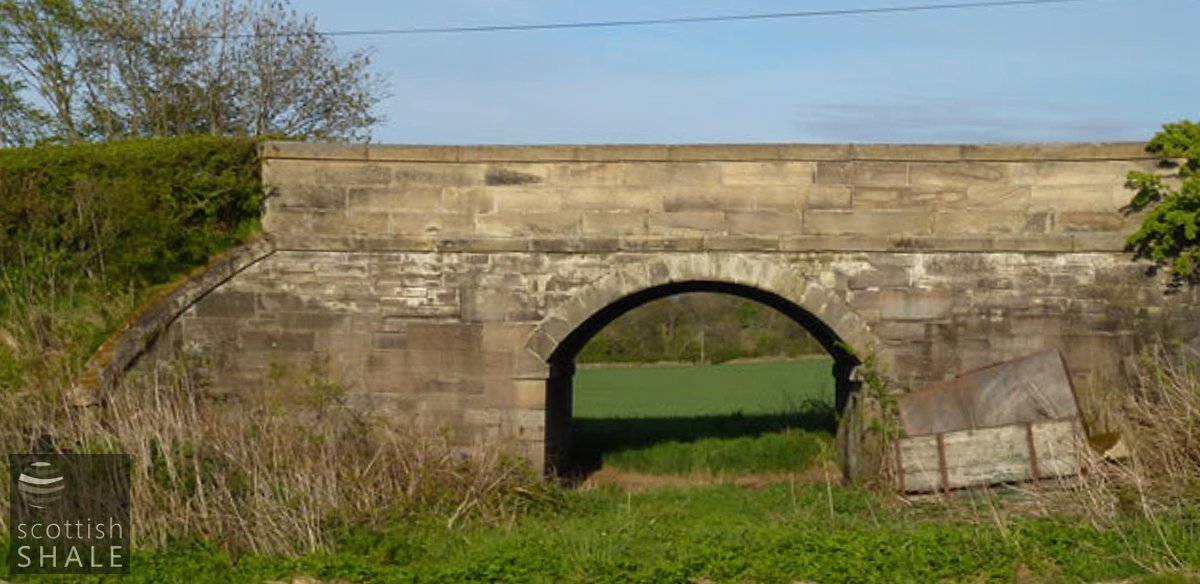Railways of Champfleurie Oil Works
Overview of Railway routes
F16001
Background
The Champfleurie Oil Works (sometimes referred to as Linlithgow Oil Works or Bridgend Oil Works) were constructed in 1884-5 by the Linlithgow Oil Company Ltd. This bold venture was promoted by a group of entrepreneurs who had little experience of the oil industry and planned to exploit reserves of oil shale that had never previously been worked. The works were constructed on an ambitious scale with four benches of crude oil retorts, an oil refinery, and a candle works. The quality of the shale failed to match expectations and the choice of an obsolete design of retort further restricted income. As a consequence, the company never prospered and eventually ceased trading in 1902. Very few official records of the Linlithgow Oil Company Ltd survive, therefore the history of the company and its railways have to be pieced together from newspaper accounts and other contemporary sources.
Routes
- The Champfleurie Railway - a standard gauge line owned and worked by the Linlithgow Oil Company Ltd, extending almost three miles between the North British Railway at St. Magdelene's, Linlithgow, and Champfleurie Oil Works. Operational 1885-1902
- Champfleurie Works - standard gauge sidings - linking the Oil Works, Refinery and Champfleurie No. 2 & 3 mines. Operational 1885-1902, with a small section reopened c.1908 - c.1912
- Champfleurie Works - narrow-gauge lines - various tramways, hutch roads and haulages conveying shale to retorts and spent shale to the bing. Operational c.1885- c.1902
- Ochiltree Colliery Tramway - narrow gauge hutch roads and haulages linking Ochiltree coal mines to Champfleurie Oil Works. Operational 1885-88 and c.1901-02
Route 1 - The Champfleurie Railway
Construction History
Champfleurie Oil Works lay about three-quarters of a mile to the south of the North British Railway's Edinburgh and Glasgow main line. The company prospectus, printed in April 1884, stated:
"The Edinburgh and Glasgow line of the North British Railway and the Union Canal both pass through the Estate of Champfleurie, thus affording ready access"..... "The surface of these fields is well adapted for making railway connection with the North British Railway or Canal, and for private branches from the pits to the works."
The landscape between the oil works and the E&G main line near Philpstoun seems to present little obstacle to a direct line of railway, however the oil company chose to build a much longer and circuitous route that linked to the North British Railway almost three miles to the west at St Magdelene's in Linlithgow. The reason for this expensive investment is unclear. The oil company ran a regular service of workman's trains therefore it is possible that the route might have been chosen specifically to transport staff to work from their homes in Linlithgow.
A manuscript letter dated June 1884 from lawyers working for Champfleurie Estate commented on the proposed route of the railway, and suggested that trains might use an existing tunnel beneath the Linlithgow to Winchburgh road, which previously carried a tramway linking Kingscavil quarries with a wharf on the Union Canal. The route is shown on the first edition OS map c.1856. It seems unlikely that this suggestion was ever considered seriously.
It seems that construction of the line was not without difficulties. At the company's first annual general meeting, held in August 1885 it was reported:
"The chief difficulty was the railway; opening up the works with the North British system at Linlithgow. The failure of the health of the contractor caused a delay of about three months, but now they had got their line completed by Messrs Stratton. It extends to nearly four miles, and was a very heavy part of the undertaking; but they could not avoid it, and they now had the advantage of having their fields opened up by a line belonging to themselves, thus securing a better outlet at more moderate rates than they otherwise could have been obtained. The railway had been open since May and was working most satisfactorily."
In a court case reported in the press, the contractors; G.W. & G Stratton, were sued for damages by Charles Collins, employed by them as a labourer. During the construction of the railway, Collins was injured beneath a number of wagons. He claimed that the arrangement of buffers and coupling of these wagons was defective.
The delay in completing the railway meant that much material for the construction of the oil works had to be transported by road. The Linlithgow District Road Committee (reported in The Scotsman), gave consent for the construction of bridges at Park and Bridgend and agreed to accept £130 towards damage to roads caused during construction of the oil works. At a subsequent meeting (reported in Glasgow Herald 11th July 1885) the board agreed to:
"apply to the Linlithgow Oil Company for a further contribution of £65 for damage done to the roads by their extraordinary traffic".
Another account reported the death of John M'Call, crushed beneath a wagon hauled by a traction engine engaged in transporting materials to the works
An article published in The Scotsman, in January 1887, described the railway when finally in full operation;
"Between the works and Linlithgow Station a substantially built railway has been laid down, over which the Company's locomotives and plant are constantly passing, and on which the men residing at Linlithgow are conveyed to and from their work at stated times of the day and night. The traffic to and from the works has greatly taxed the accommodation for goods at Linlithgow station, and it is understood that the North British Railway Company are engaged in devising measures for the enlargement of the area on which mineral and goods waggons can be accommodated."
Description of the Route
The well-engineered route of the Champfleurie Railway began in St Magdelene's goods yard (55.977004, -3.590851), just to the east of Linlithgow railway station and ran parallel to the Edinburgh and Glasgow main line for about 1,600m. Rising gradually on an embankment it swung to the south, crossing the Union Canal on a skew bridge (55.977106, -3.565544) ; the curve of the line then reversing before passing beneath an elegant stone-built overbridge (55.974448, -3.558711) carrying the road between Kingscavil and Park. Continuing eastward, the line entered the grounds of Champfleurie House, the route being screened from view by an existing belt of trees.
Turning sharply southward, the line climbed, with an embankment leading to a bridge across the Linlithgow - Winchburgh road (55.969053, -3.537327), the substantial embankment continuing south of the road until the site of the oil works was reached (55.964851, -3.540805). The length of the line from St Magdelenes to the retorts of Champfleurie Oil Works was two and three quarter miles; the OS map shows a milepost beside the railway in Champfleurie estate, which seems to mark two miles from St Magdelenes. The line was single track throughout; the OS map shows a loop, about 320 yards long, immediately east of St Magdelenes, with a loop of similar length at the eastern end of the line, adjacent to the oil works retorts. The map also show trap points either side of the Bridgend bridge, also a weighbridge close to the southern set of points.
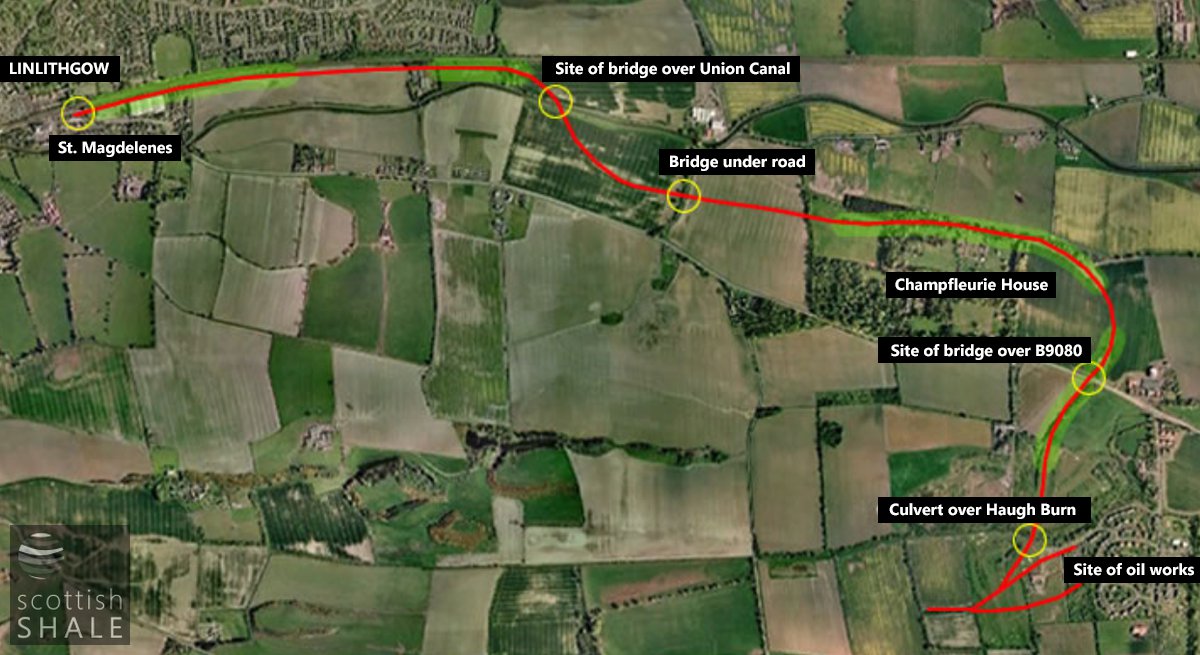
Route plotted on Google Earth, showing major features, with highlighted areas indicating where the earthworks remains intact.
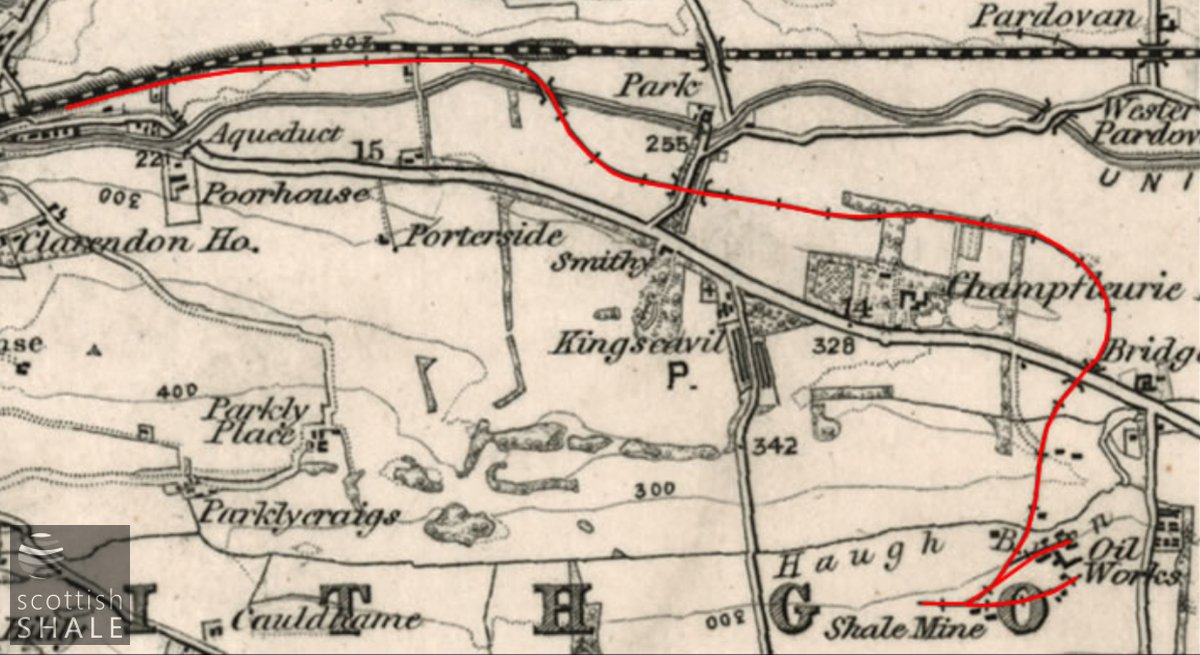
Route plotted on 1" OS map c.1904.
Above: Route plotted on Google Earth, showing major features, with highlighted areas indicating where the earthworks remains intact
Above right: Route plotted on 1" OS map c.1904
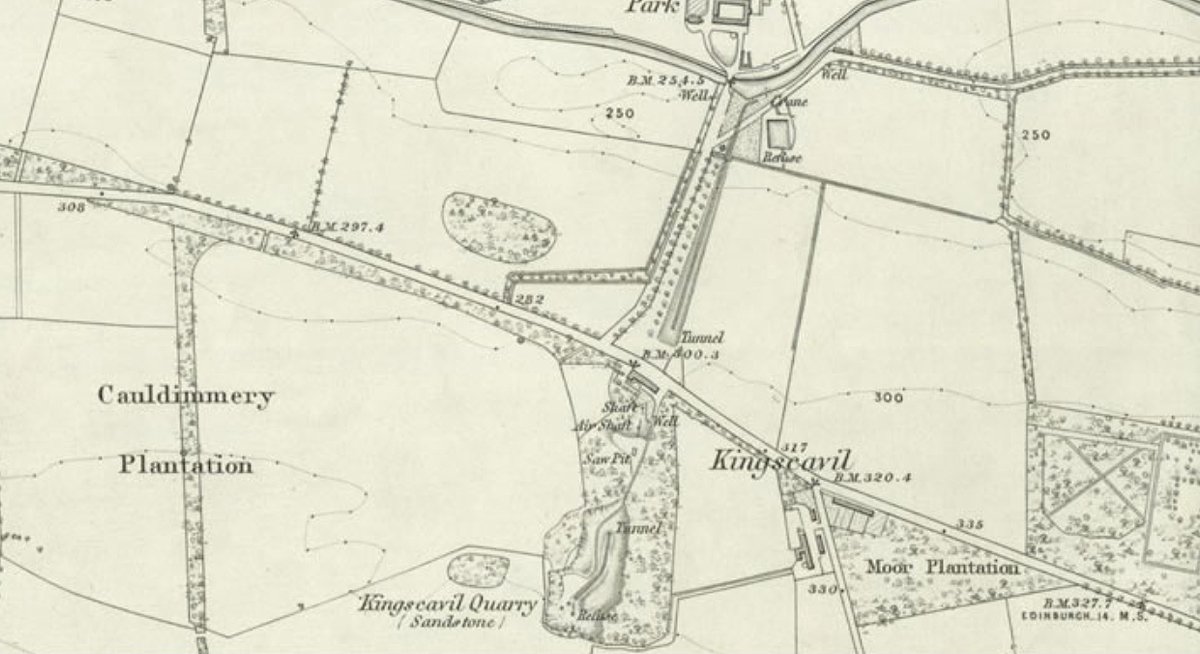
Route of the Kingscavil quarry railway shown the the first edition (1856) 6" OS map.
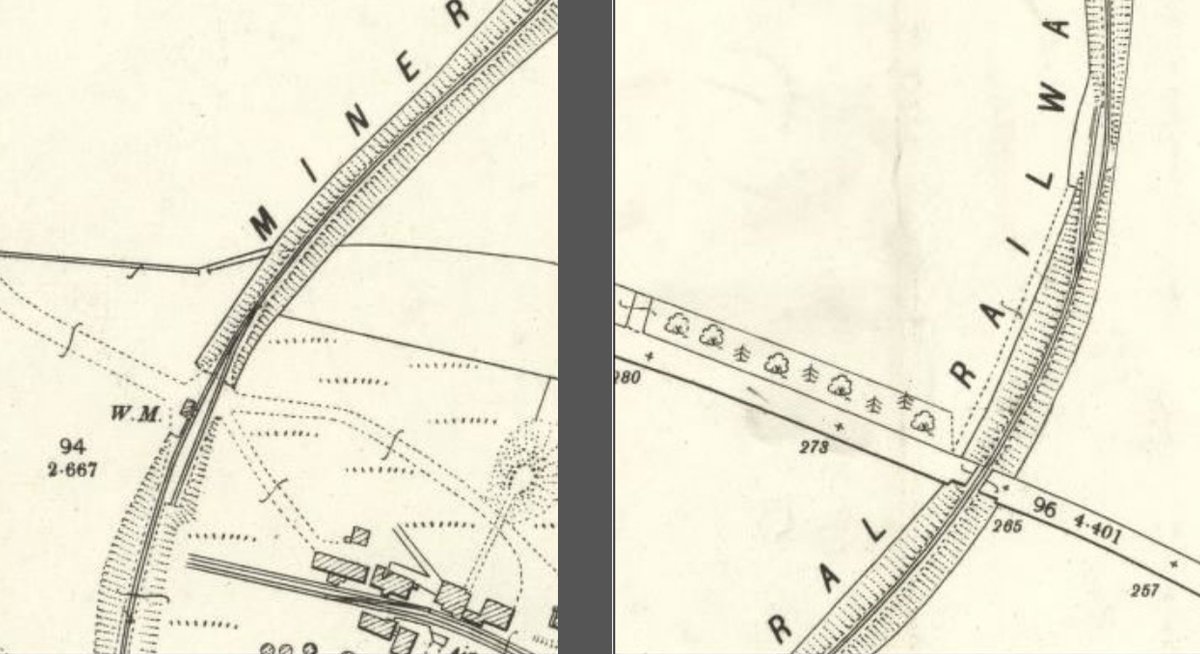
Details of trap points either side of the Bridgend bridge over the Linlithgow to Winchburgh road.
Above: Route of the Kingscavil quarry railway shown the the first edition (1856) 6" OS map
Above right: Details of trap points either side of the Bridgend bridge over the Linlithgow to Winchburgh road
Detailed view of the route, west to east, from 6" OS maps c.1896
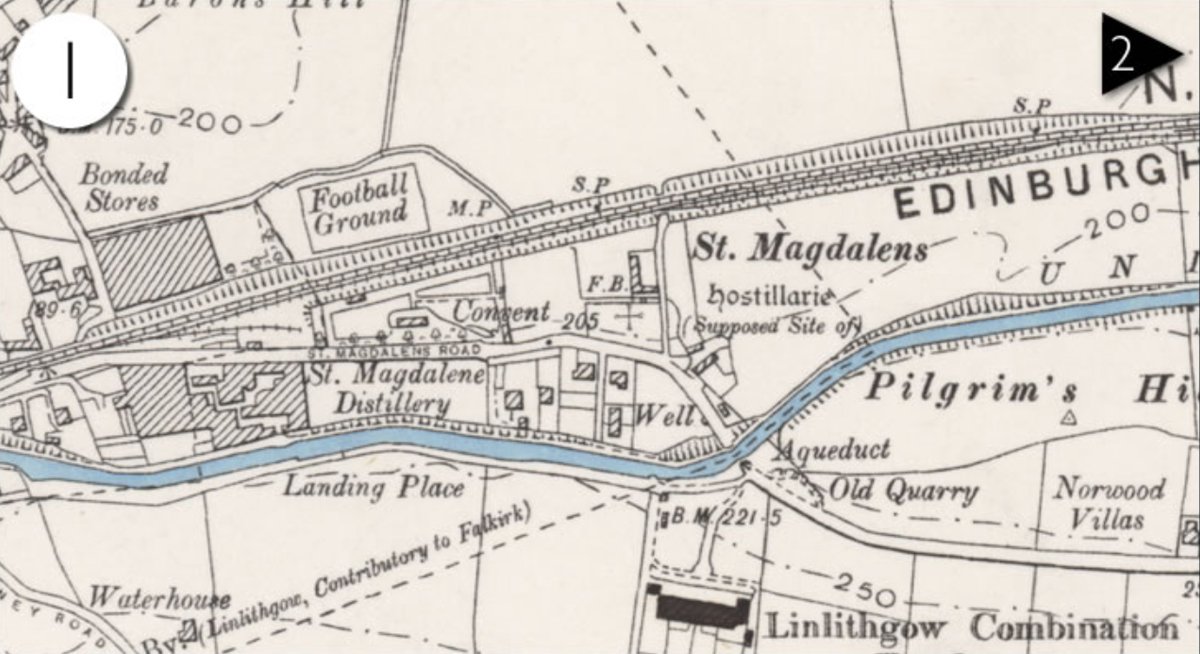
Detailed view of the route, west to east, from 6" OS maps c.1896
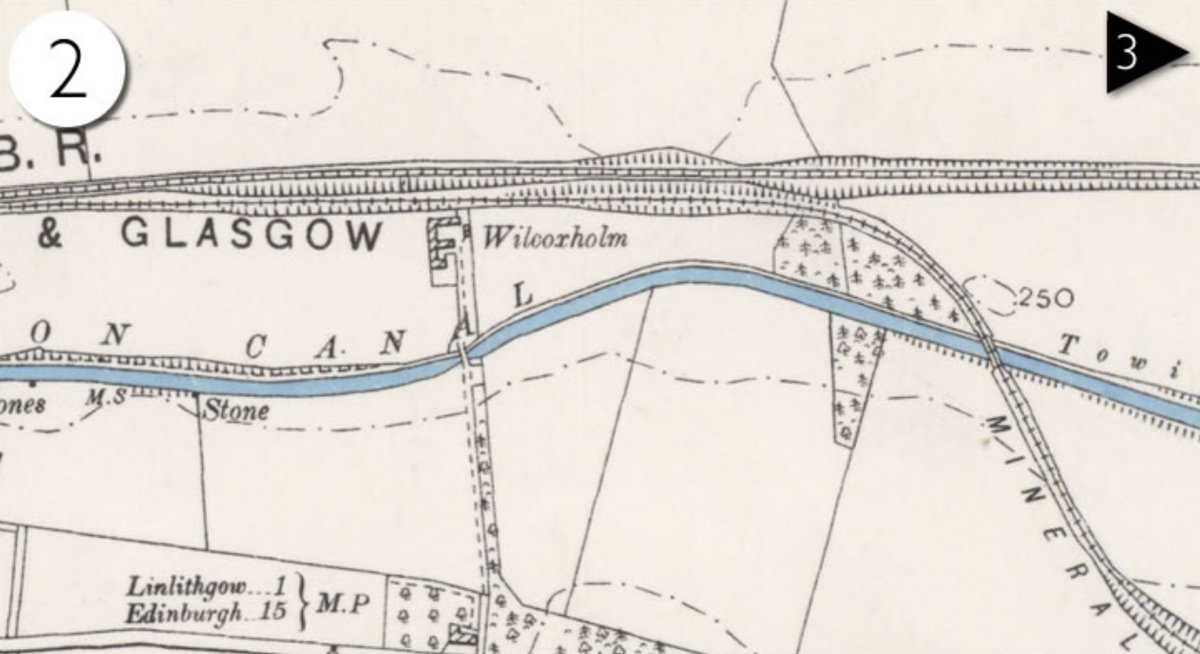
Detailed view of the route, west to east, from 6" OS maps c.1896
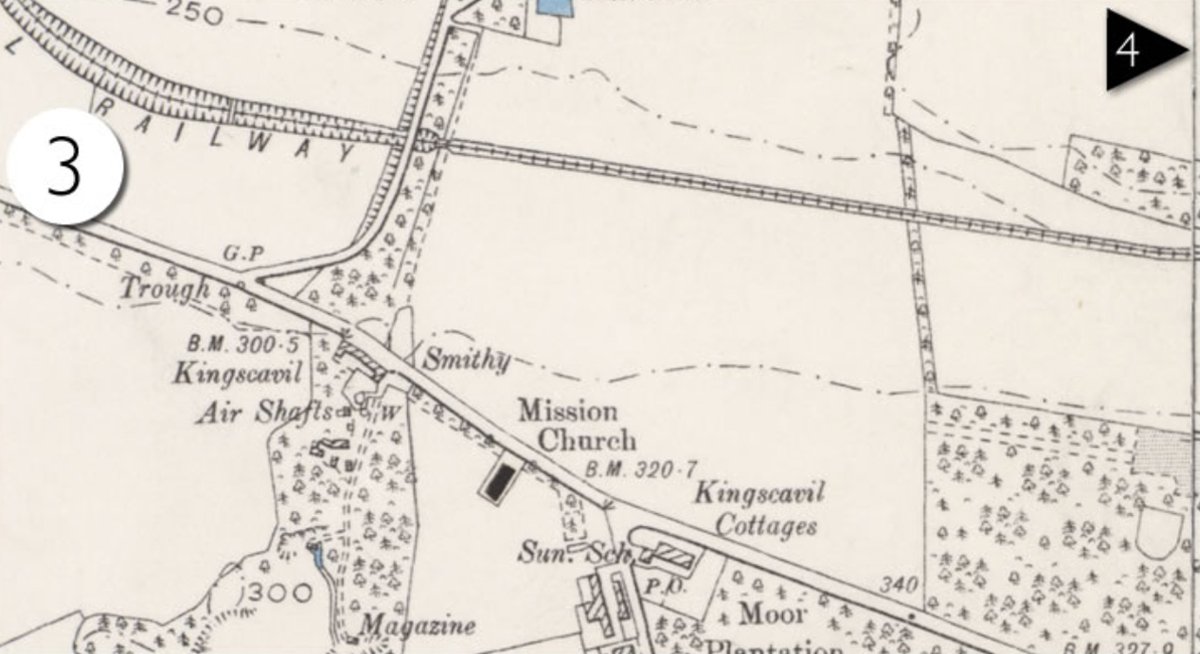
Detailed view of the route, west to east, from 6" OS maps c.1896
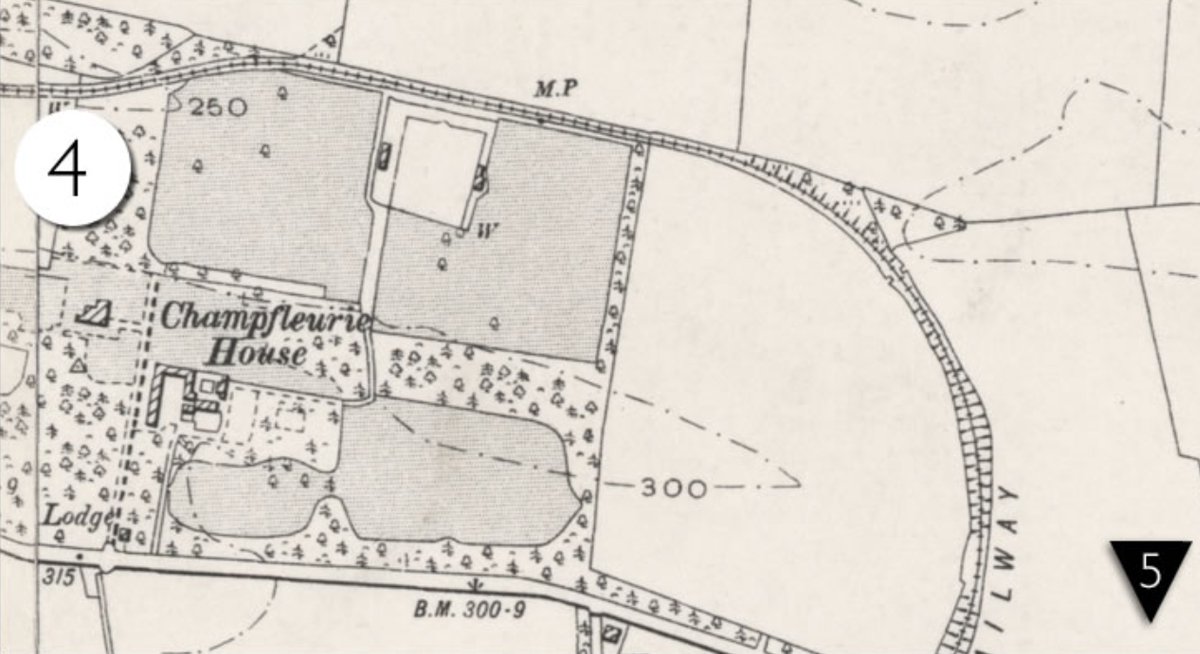
Detailed view of the route, west to east, from 6" OS maps c.1896
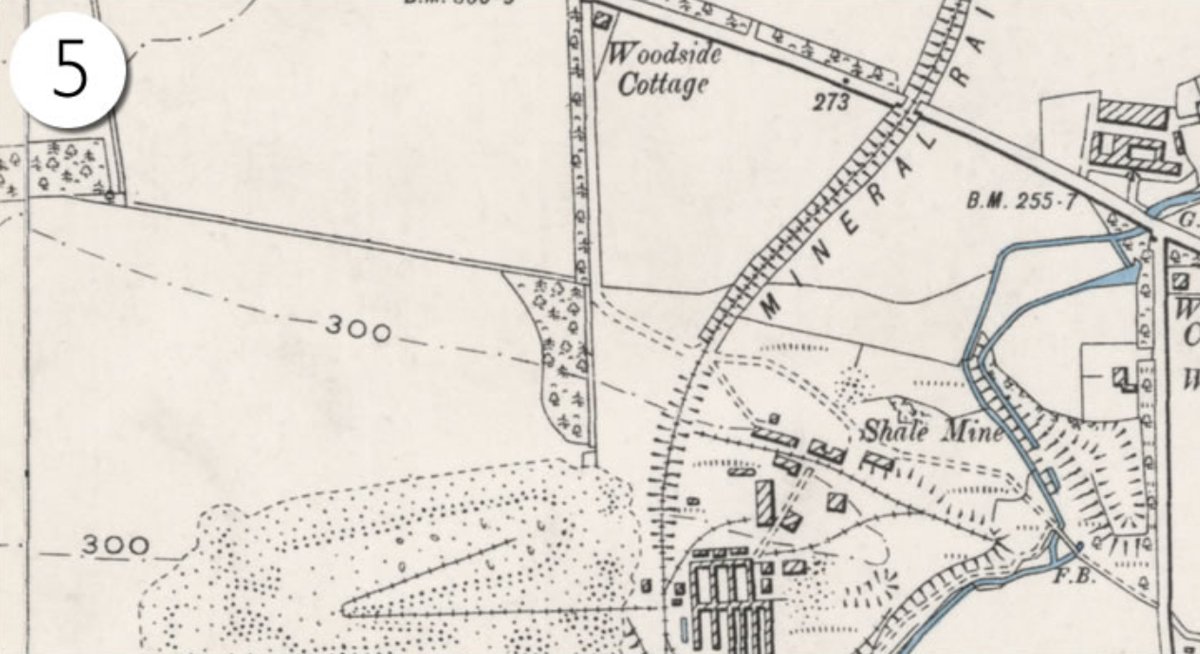
Detailed view of the route, west to east, from 6" OS maps c.1896
Detailed view of the route c.2005, from Google Earth images
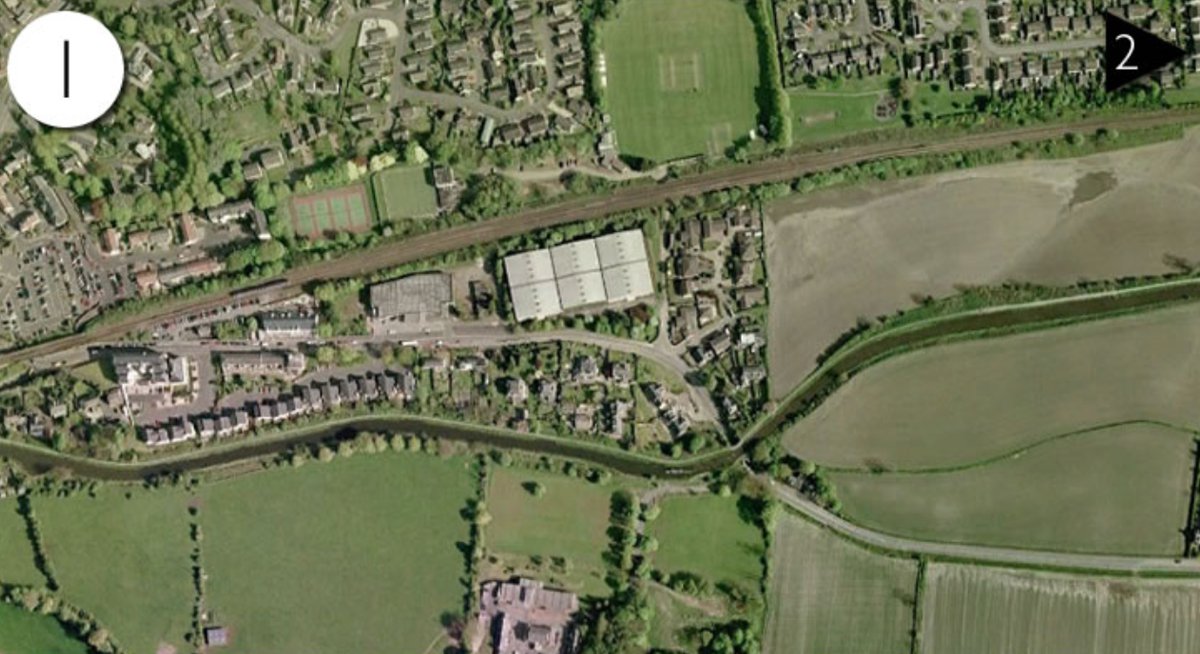
Detailed view of the route c.2005, from Google Earth images
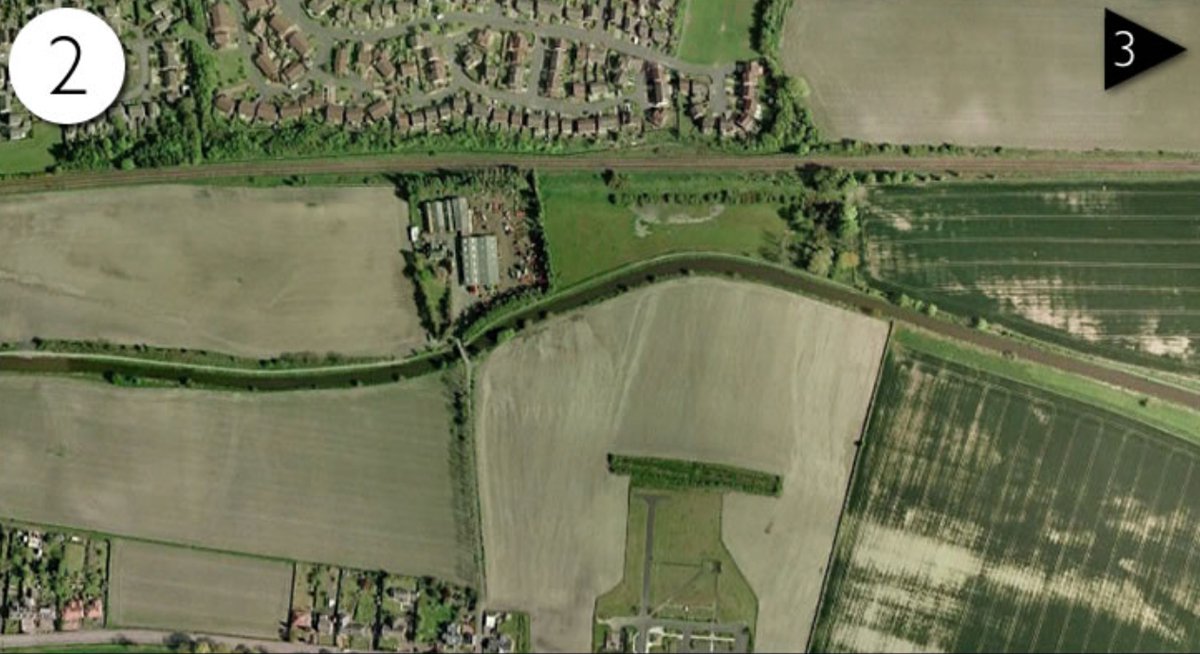
Detailed view of the route c.2005, from Google Earth images
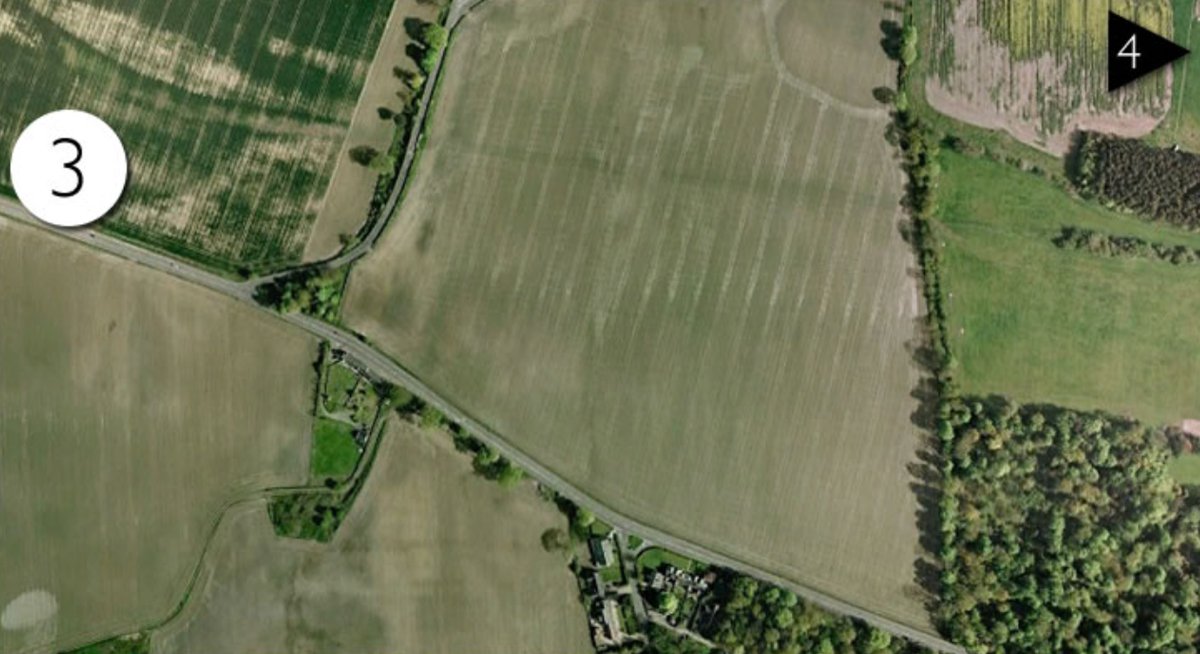
Detailed view of the route c.2005, from Google Earth images
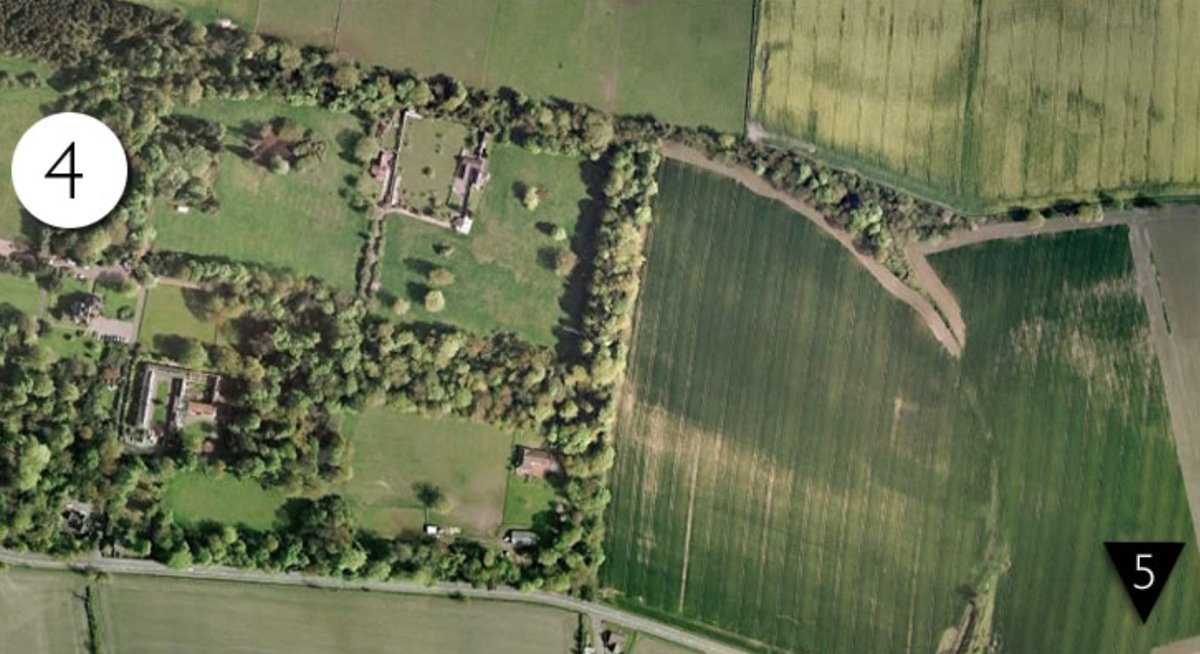
Detailed view of the route c.2005, from Google Earth images
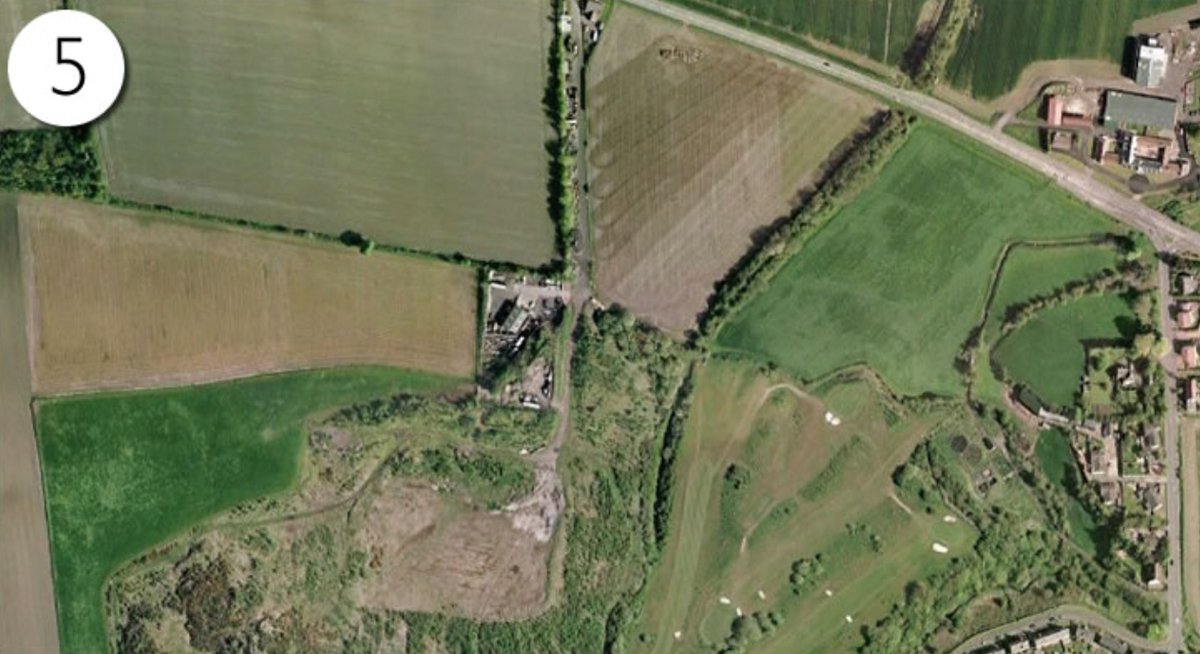
Detailed view of the route c.2005, from Google Earth images
Traffic and Operation
It appears that the oil company worked all traffic over the line throughout its history. Goods into the works are likely to have consisted of coal, sulphuric acid and other chemicals, plus crude oil; - from the outset the refinery had spare capacity and crude oil was bought in for refining from Young's, Holmes, Hermand, and other producers. Goods out would have comprised mainly of refined oils, ammonium sulphate, wax scale, and finished products such as candles.
The line also ran workmen's trains on which - according to an article published in the Scotsman in 1887;
" the men residing at Linlithgow are conveyed to and from their work at stated times of the day and night" .
Various mischief and mishaps associated with the operation of these workman's trains were reported in the press. It might be imagined that the evening train from the pubs of Linlithgow to the rows of Kingscavil and Bridgend might have been particularly lively
- Patrick Kelly was walking along along an embankment to join the workman's train when, distracted by women, he was hit by a engine.
- Thomas Grant was injured when returning from Linlithgow to the rows when he alighted the train before it had stopped. It is not stated whether he had enjoyed the hospitality of Linlithgow's many public houses, and whether it was usual practice to stop the train near Park to serve the residents of Kingscavil rows.
- Michael Connor and Frank Douglas came close to derailing the workman's train in a drunken joke. Each were sentenced to 60 days imprisonment with hard labour.
- James Donoghue, knocked over in the "east railway sidings", Linlithgow while going for the workman's train, then carried on a wagon end door as a makeshift strecher.
It might be imagined that a Saturday evening train from the pubs of Linlithgow to the rows of Kingscavil and Bridgend would have been particularly lively
In the early, optimistic days of the company a "shareholder excursion" was organised to introduce investors to the new works. A special train of first class carriages was run from Edinburgh to Linlithgow then, apparently, along the Champfleurie railway to the oil works. After a tour of the site, a fine luncheon in the cooperage, and many rounds of self-congratulatory speeches, the group of 160 boarded their train for the homeward journey.
Other incidents reported in the press relate to the general traffic on the line.
- Alexander Grant who was pulled along by a train after bathing in the Union Canal
Rolling Stock
The Industrial Railway Society in their Handbook N - Industrial Locomotives of Scotland (published 1975) lists three locomotives that are thought to have worked at Champfleurie Oil Works
- THE STAG - An 0-4-0ST with outside cylinders, built by Barclays & Company of Kilmarnock (249 of 1878), shown to have been disposed of to James Ross & Company, Philpstoun Oil Works c.1910
- A second 0-4-0ST with outside cylinders, built by Barclays & Company of Kilmarnock, identity and details of disposal unknown
- An 0-4-0ST with outside cylinders, built by Dick and Stevenson of Airdrie, identity and details of disposal unknown
It seem a little surprising, given the generous expenditure on other equipment, that the company did not purchase a new locomotive for the opening of its railway. It is not known whether more than one locomotive worked at Champfleurie at any one time. The small loco shed shown on a plan of the works would seems only large enough to house a single engine, along the 1896 OS map shows a further rail connected shed associate with it. A newspaper account of 1900 relates how the pug engine had been blown off the track by high winds and "burst its boiler"!
A locomotive (singular) is listed in preliminary lists for the plant and equipment sale following the liquidation of the company in 1902, but was not included in the final sale list. This locomotive (presumably THE STAG) was reported in October 1902 to be used in hauling equipment to Linlithgow during the dismantling the oil works. An accident to a schoolboy in May 1903 shows that the pug was still working the Champfleurie railway at that late date, seemingly taking local children to their studies at Linlithgow Academy.
Sold subsequently to James Ross & Company of Philpstoun Oil Works, it is quite possible that THE STAG worked trains between Philpstoun and Champfleurie No.3 when that mine was re-opened and a new connecting line constructed.

An unidentified locomotive shunting at Philpstoun Oil Works - apparantly a Barclay piano tank. Might this be "The Stag" that, earlier in its life, enjoyed many adventures on the Champfleurie Railway?
It is not known what rolling stock was used for the workman's trains on the Champfleurie Railway. It might be imagined that staff travelled in old coaches rather than open wagons, but there is no evidence of this. No standard gauge rolling stock was listed in the liquidation sale notice other than a locomotive and tank waggons. As with the locomotive, the tank waggons seem to have been sold prior to the sale.
Decline & Dismantling
Captain Johnston Stewart, owner of the Champfleurie Estate, and Lord Rosebery, owner of the Ochiltree estate, were major creditors on collapse of the company. Both took court action to retain assets. Following the auction sale of plant and equipment it was reported that the branch railway remained in the possession of these proprietors. It is assumed that the track was soon sold as scrap.
Much of the route of the railway has now been levelled and returned to agriculture. At St Magdelene's the route is marked by a slightly wider area now enclosed within the main line railway boundary. Immediately east of Wilcoxholm, running parallel with the main line, a length of embankment remains where the line once climbed to cross the Union Canal. Thereafter the line is almost completely ploughed out until entering the policies of Champfleurie House where the route survives through the parkland. East of Champfleurie a small stretch of trackbed has been ploughed out, but much of the embankment which carried the line to the oil work sites remains. Of the three significant bridges on the route, the bridge across the Linlithgow to Winchburgh road (The A9 in pre-motorway days) has been removed and embankments trimmed back significantly on both sides. Solid stone abutments survive on both sides of the Union Canal where the railway once crossed on the skew. The solid stone-built bridge that once carried the railway beneath the Kingscavil to Park road remains intact, but mostly unnoticed.
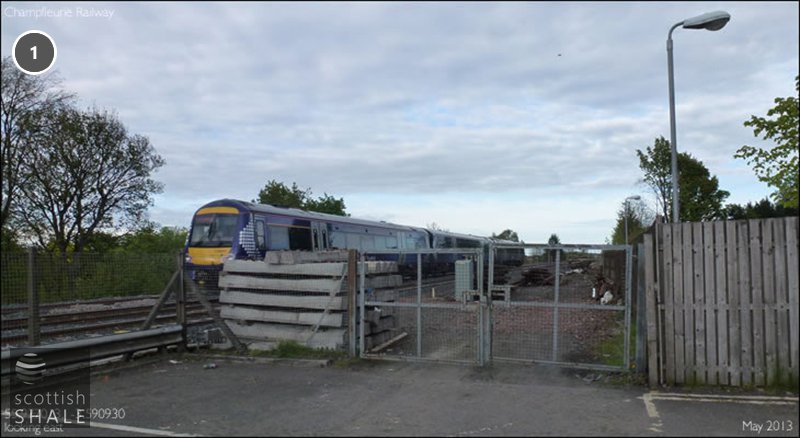
Site of St Magdelenes good yard, Linlithgow, the yard gates marking the route of the Champfleurie railway
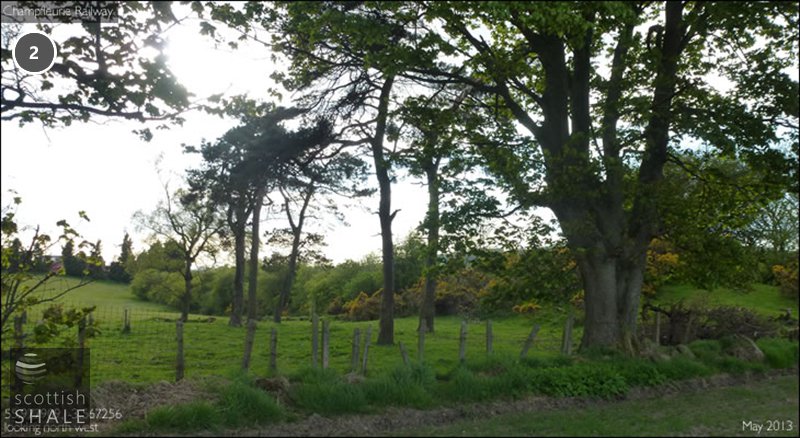
Wooded embankment, immediately east of Wilcoxholm, where the line climbed to cross the Union Canal
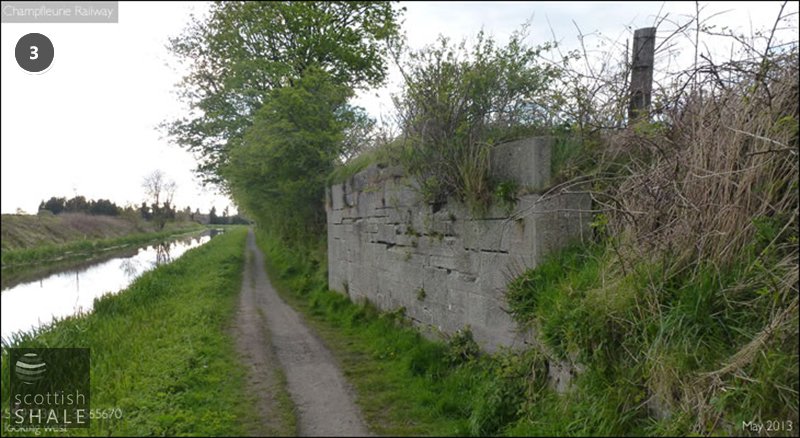
North abutment of bridge across the Union Canal
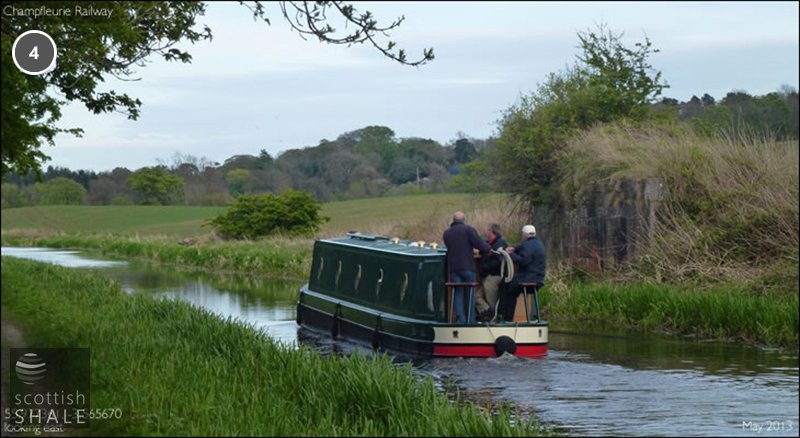
Southern abutment of bridge over the Union Canal
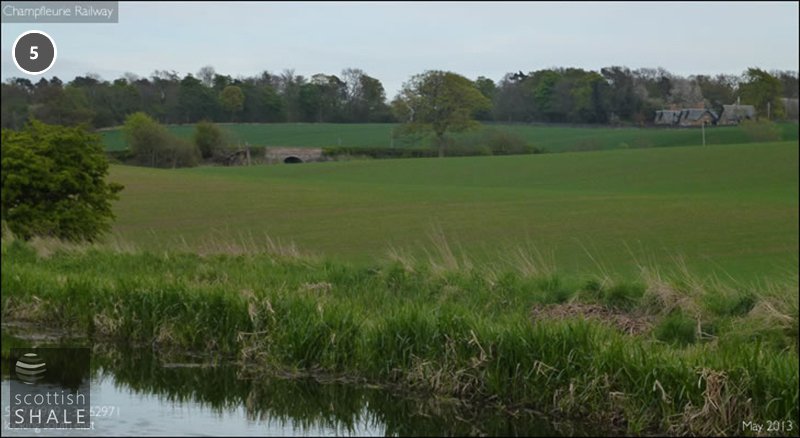
View from the west towards the Kingscavil to Park road, showing the underbridge
Above:
- (1) Site of St Magdelenes good yard, Linlithgow, the yard gates marking the route of the Champfleurie railway
- (2) Wooded embankment, immediately east of Wilcoxholm, where the line climbed to cross the Union Canal
- (3) North abutment of bridge across the Union Canal
- (4) Southern abutment of bridge over the Union Canal.
- (5) View from the west towards the Kingscavil to Park road, showing the underbridge
Below:
- (6) Stone bridge, carrying the railway beneath the Kingscavil to Park road
- (7) View beneath Park bridge towards Champfleurie House
- (8) Embankment and site of bridge over the Linlithgow to Winchburgh road.
- (9) Embankment to the north of the Linlithgow to Winchburgh road, with site of the oil works and bing centre right
- 10) Abutment wall of the causeway over the Haugh burn, linking the crude oil works with the refinery
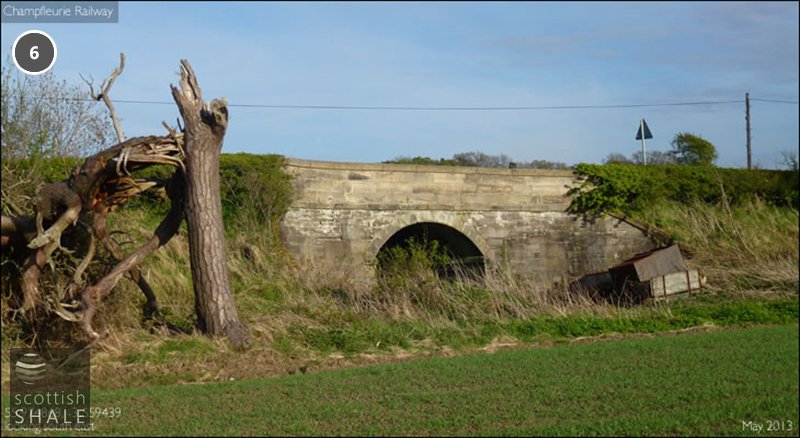
Stone bridge, carrying the railway beneath the Kingscavil to Park road
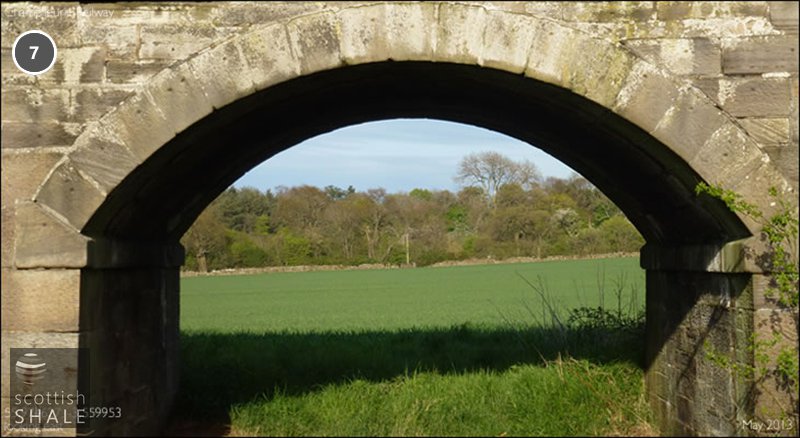
View beneath Park bridge towards Champfleurie House
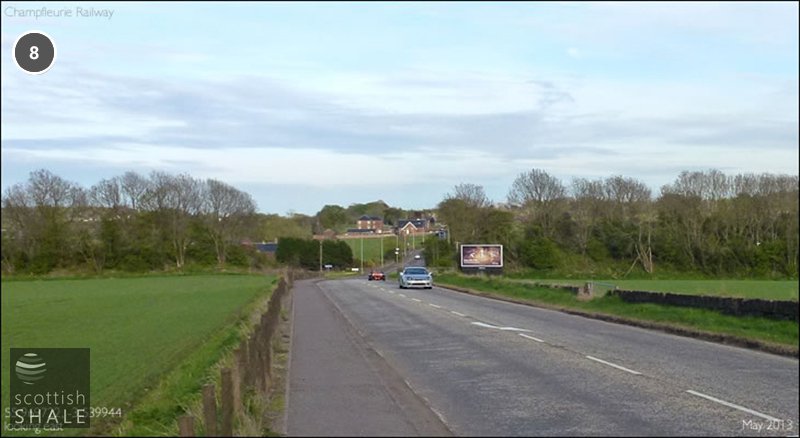
Embankment and site of bridge over the Linlithgow to Winchburgh road
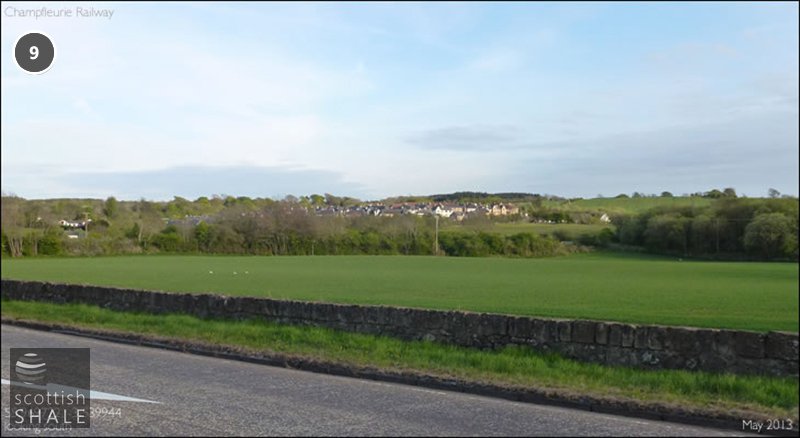
Embankment to the north of the Linlithgow to Winchburgh road, with site of the oil works and bing centre right
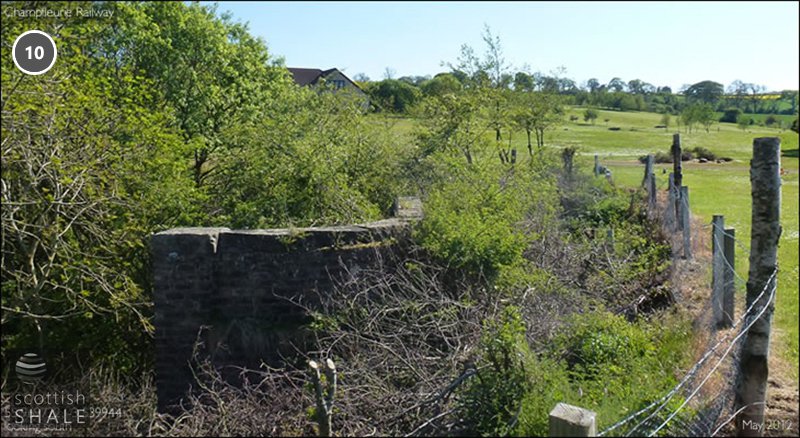
Abutment wall of the causeway over the Haugh burn, linking the crude oil works with the refinery
Route 2 - Champfleurie Oilworks - standard-gauge sidings
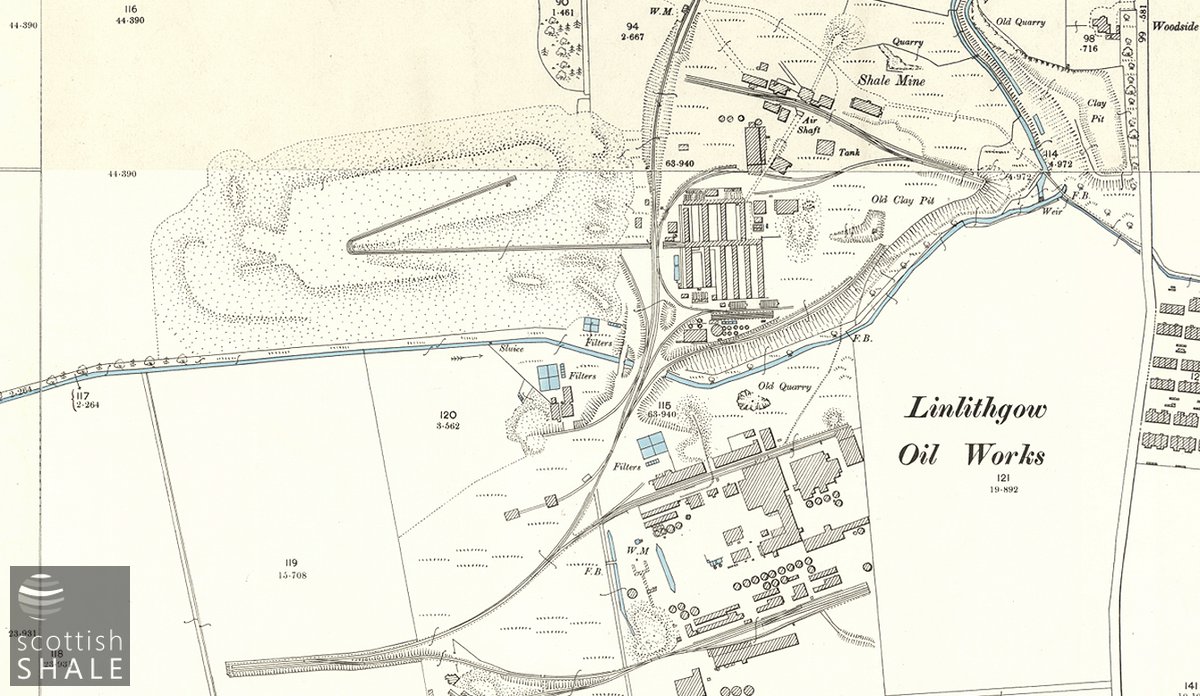
The second edition 25" OS map, published c.1896, illustrates the layout of the works and its railways, which seems to have changed little through the working life of the plant. An undated blueprint plan of the works (in the BP archive) shows a virtually identical layout; the annotation from this has been transferred to the OS map on the Champfleurie Oil Works page.
Champfleurie oil works straddled the Haugh Burn, which marked the boundary between the Champfleurie and Ochiltree estates. The crude oil retorts and the spent shale bing lay within the Champfleurie estate, on an area of relatively flat ground to the north of the burn. Champfleurie No. 1 mine was sited on slightly lower ground immediately to the north of the retorts. The oil refinery, workshops and candleworks lay on sloping ground south of the Haugh burn in the Ochiltree estate. Most of the refinery buildings ran parallel to this slope. The two parts of the site were linked by a substantial causeway, constructed with brick retaining walls, beneath which the Haugh burn passed in a culvert. The railway passed across this causeway.
One the north of the burn, railway sidings extended either side of the retort; one route reversing and falling to serve Champfleurie No.1, where a shale breaker was installed "at ground level". To the south of the burn the railway swung to the west and gained height, a number of sidings trailed from this route to the refinery. One of these sidings reversed, and climbed to serve Ochiltree No.2 & 3 mines.
The map suggests that the output of Ochiltree No. 2 & No. 3 mines was discharged into standard gauge wagons from an overhead gantry. The wagons would then have travelled downhill, changing direction of three occasions before reaching the ground-level shale breaker serving Champfleurie No.1 mine, where the wagon would be emptied by hydraulically powered tipper.
A number of shunting accidents within the works were reported in the press.
- John Robertson who took the oil company to court after falling into an open trench while shunting waggons
- John Dewar who was crushed between waggon buffers
Reference
National Archives of Scotland (RHP6380) 'Plan of siding at Linlithgow Oil Coy's works'. By Robert Stewart, surveyor, Glasgow.
Scale [1:160] 3/4 inch = 10 feet. 577 x 1110 mm. Ink and colour wash. Annotated in ink. Linen backing.
Plan coloured to show the siding next to the pit head. Breaking engine house and hauling engine house noted. Section showing distances along the rails before and after the breaker and staging, dated 25th June 1892.
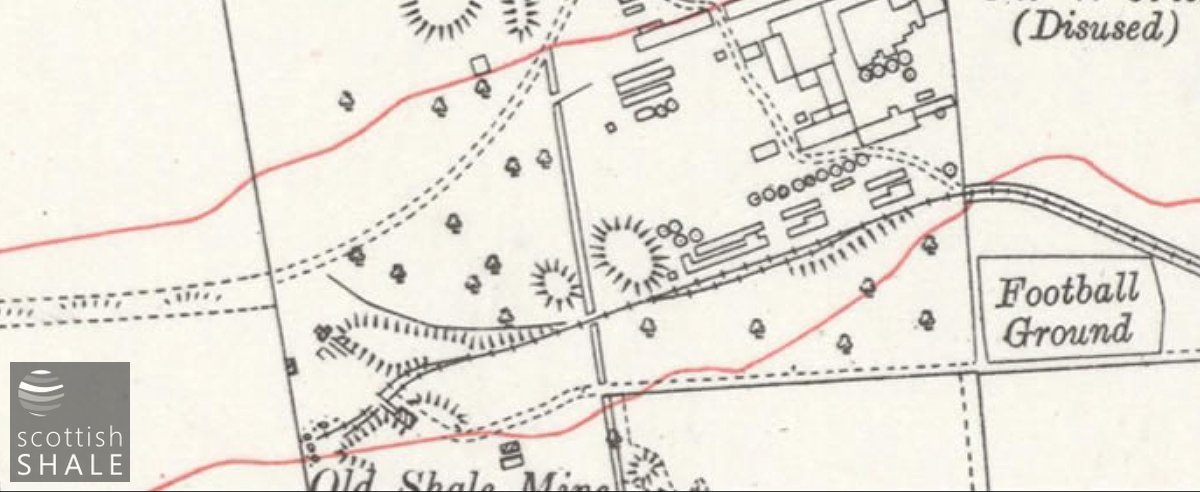
The 1914 6" OS map shows the oil works in a derelict condition with many buildings intact, but with all railway lines removed, except for the southernmost siding. This track seems to have been retained or reinstated as part of a new line to Philpstoun No.4 mine, from where James Ross & Company's existing railway linked to Philpstoun Oil Works. James Ross & Company. reopened Champfleurie No. 3, and constructed the new linking line, which crossed Auldhill Road on the level, in c.1908. The mine, and presumably the railway, was abandoned c.1912.
Route 3 - Champfluerie Oil Works - narrow-gauge lines
A newspaper account dated 1885 described how hutches of shale from Champfleurie No. 1 mine were tipped into the ground-level shale breaker serving the mine. Hutches of broken shale were then "passed up an incline to the top of the retort bench". Such hutches usually had a bottom-discharge mechanism allowing shale to be charged into the head of each retort. It also describes how hot spent shale, discharged from the base of each Henderson report, was loaded in iron hutches, which were then run through a dipping hole filled with water to quench the hot shale. Hutches of spent shale were then drawn up the spent shale bing by "endless chain". The account also mentions that hutches were used to convey ammonium sulphate from drying bin to loading bay.
The 1895 25" OS map shows few details of these tramways and haulages; the incline from breaker to the top of retorts seemingly being marked only by a double dotted line. The spent shale haulage is shown climbing the bing and negociating a 150 degree curve to enable waste on the eastern face of the bing. The hatching describing the contours of the bing suggest a number of earlier routes of this haulage. The haulages drawing hutches from the Ochiltree No. 2 & No. 3 mines are clearly drawn, serving a roofed staging beneath which passed the standard gauge siding.
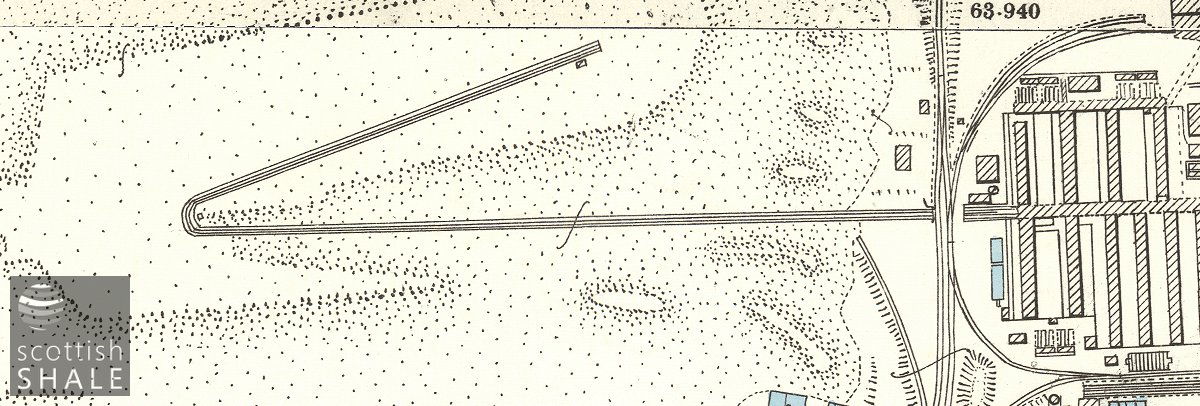
Detail of 25" OS map c.1895 showing spent shale haulage. Two sets of rails emerge from beneath the retort; the tanks of water perhaps serve the "dipping hole" in which wagons were quenched before passing beneath the standard gauge sidings and climbing the bing.
Above: Detail of 25" OS map c.1895 showing spent shale haulage. Two sets of rails emerge from beneath the retort; the tanks of water perhaps serve the "dipping hole" in which wagons were quenched before passing beneath the standard gauge sidings and climbing the bing.
The Linlithgow Oil Company also operated small scale and short-lived shale workings at Ochiltree No. 5 and Ochiltree No. 6 mines, and possibly other exploratory workings. Clay was also worked at pits on the slope above the oil works (55.958860, -3.536096) from which bricks were made from construction of works and buildings and worker's rows. It seems likely that temporary horse-hauled hutch roads were laid to serve these operations, however no historical record of these have yet been found.
Route 4 - The Ochiltree Colliery Tramway
At the first AGM of the Linlithgow Oil Company, held in August 1885, it was announced;
"They had now a colliery on the Ochiltree property, from which they expected to be able to supply the present necessities of the works in the way of fuel. That was a very exception thing regarding an oil work; but he was glad to be able to say that they were able to get coal, which meant a very considerable saving to them."
This colliery at Ochiltree lay on the southern face of a considerable ridge running east to west, along the top of which ran the Ochiltree road. The oil works lay three quarters of a mile to the north, on the north face of the ridge. Coal therefore had to be hauled up the south face of the ridge, climbing about 50 ft, before crossing the Ochiltree road, and then dropping about 120ft to the works.
A manuscript report in the BP collection indicates that a hutch road (tramway) was installed to link the coal mine to the oil works, but this was only ever intended to be a temporary facility. The horse-drawn hutch road climbed the ridge, crossed the Ochiltree road on the level, and followed the verge of Ochiltree to Bridgend road as far as the brick works. From here the hutches descended by a gravity-worked incline to the works. The crossing of the public road was agreed with the Linlithgowshire Road Trustees;
"The state of the Auldhill road from Bridgend to Ochiltree was considered; also a communication from the Linlithgow Oil Company, offering to make a hutch road from their coal works along side the present road." (The Scotsman, 6th February 1886)
"It was reported that an arrangement had been made with the Linlithgow Oil Company in regards to their level crossings and hutch road." (The Scotsman, 10th April 1886)
With the high cost of transport by temporary hutch road, it soon proved cheaper to buy-in coal supplies, and the Ochiltree colliery was closed in 1888. The manuscript report (probably written in the late 1890's) indicates that the Road Trustees had refused to allow a level crossing of the Ochiltree road by a more efficient permanent tramway or haulage, insisting that a bridge be constructed to carry the tramway beneath the road. The oil company considered this did not warrant the investment. The report went on to propose a new mine be sunk from a site to the north of the Ochiltree road that would join underground to the earlier workings. From this new mine site a new powered, rope-worked haulage could be installed directly to the works without need to cross the public road.
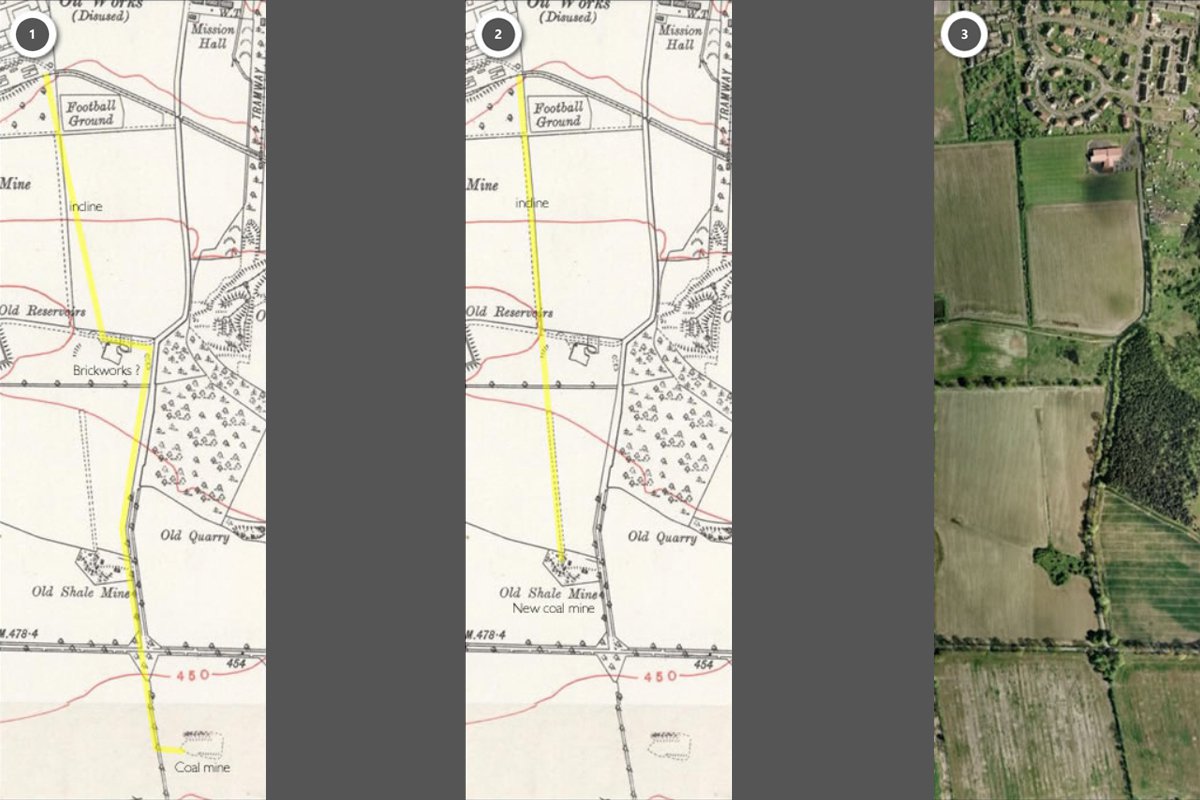
- (1) Probable route of temporary hutch road between Ochiltree colliery and Champfluerie Oil Works, operational 1885-1888
- (2) Route of haulage from new Ochiltee colliery to Champfleurie Oil Works, operational c.1900 - 1902
- (3) Google Earth view of the area
Above:
- (1) Probable route of temporary hutch road between Ochiltree colliery and Champfluerie Oil Works, operational 1885-1888
- (2) Route of haulage from new Ochiltee colliery to Champfleurie Oil Works, operational c.1900 - 1902
- (3) Google Earth view of the area
It appears that the oil company accepted the advice of the report and invested £5,332 in the sinking and fitting out of the new mine in c.1900, including the construction of a substantially engineered incline following a straight route direct to the works (for references see Ochiltree Collieries). Difficulties were experienced in sinking of the mine, which may have contributed to the failure of the company in 1902 and the abandonment of all operations..
A number of brick foundations and engine plinths survive at the site of the new Ochiltree coal mine (misleadingly labelled "old shale mine" on OS maps), some of which seem likely to relate to the haulage engine house. Most of the earthworks of the incline remain intact and the route is now marked by a line of electricity supply poles. A 130 metre gap in earthworks across the former brickworks site presumably represents the site of a bridge or trestle structure that carried the incline rails over this lower ground.
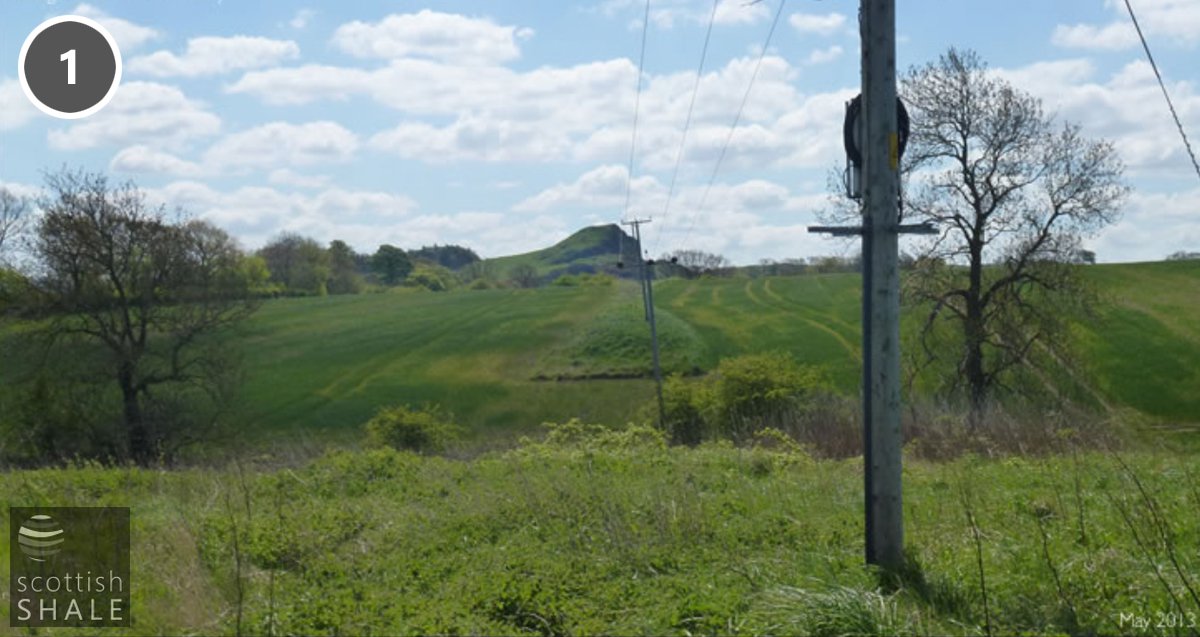
View looking south along the route of the haulage at possible site of bridge, with Binny Craig on the horizon.
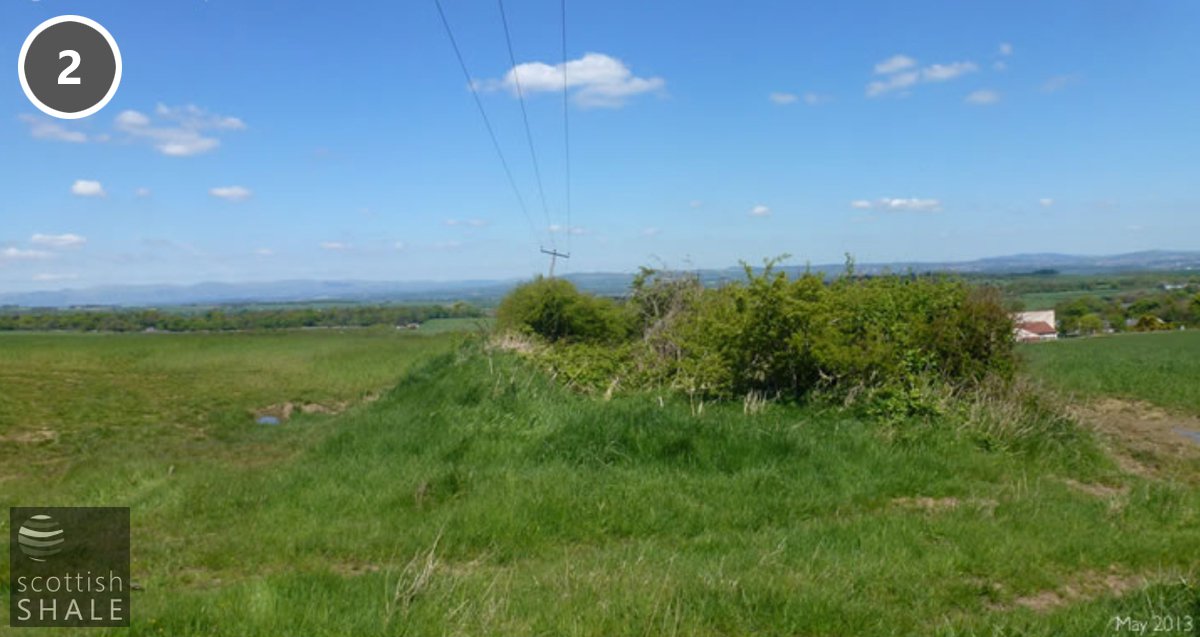
Looking north from the same viewpoint along the overgrown cutting.
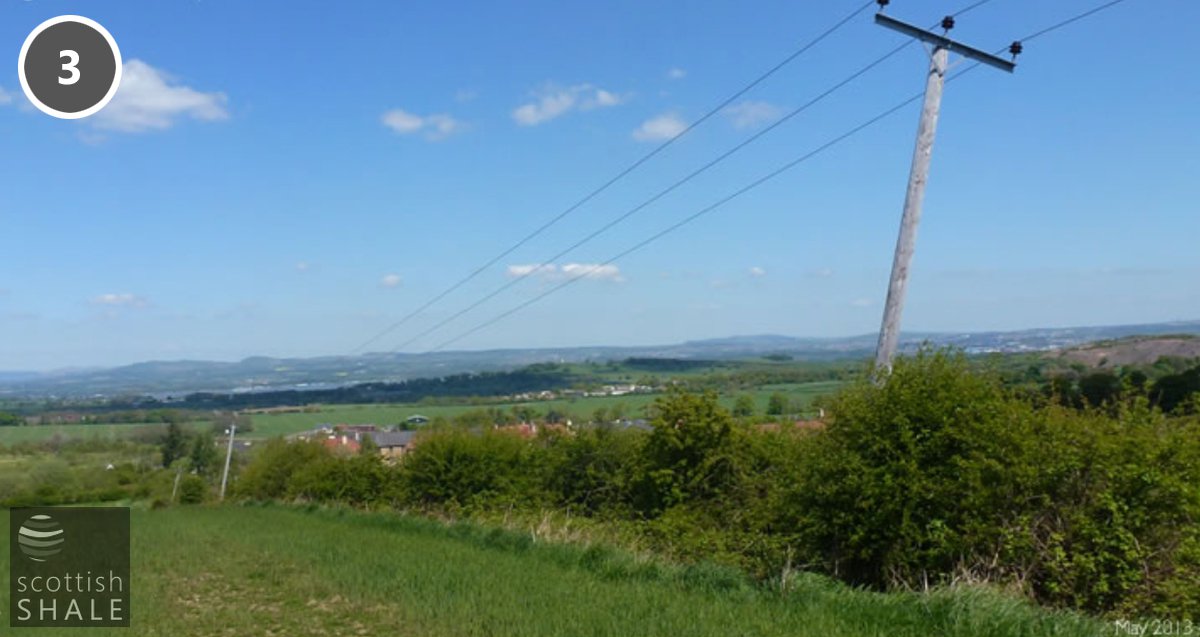
Electricity posts marking the route descending towards the oil works.
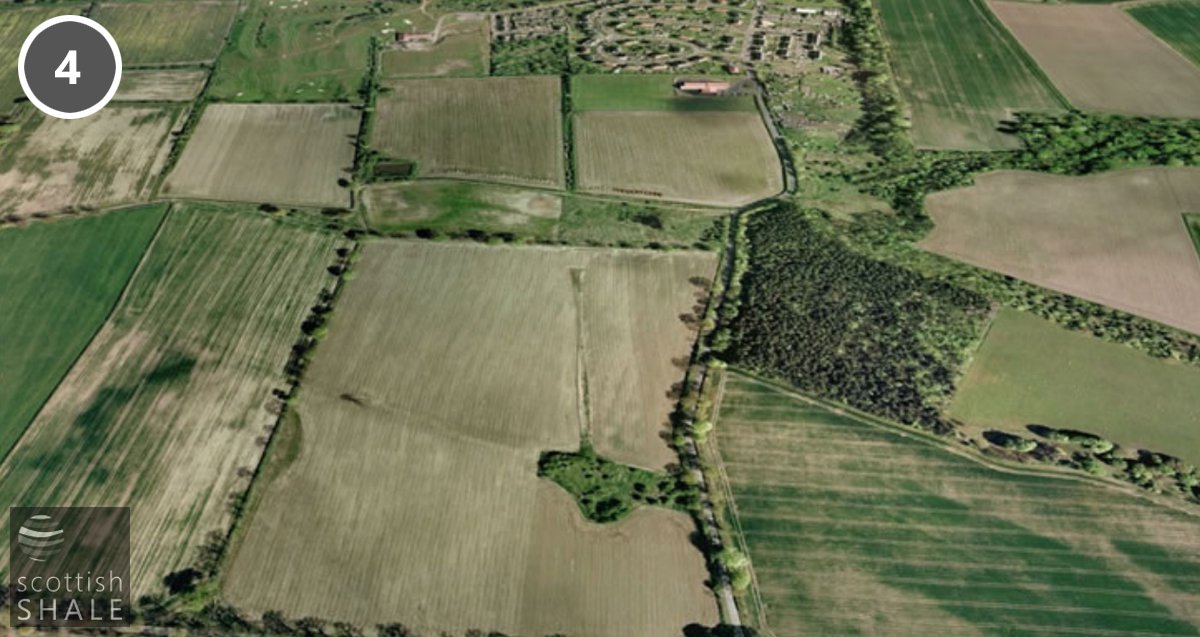
Oblique Google Earth view with new mine site in the foreground.
Above:
- (1) View looking south along the route of the haulage at possible site of bridge, with Binny Craig on the horizon
- (2) Looking north from the same viewpoint along the overgrown cutting
- (3) Electricity posts marking the route descending towards the oil works
- (4) Oblique Google Earth view with new mine site in the foreground
LINLITHGOW DISTRICT ROAD COMMITTEE
A meeting of this committee was held in the County rooms on Friday – Mr Henry Cadell of Grange in the chair. There was submitted to the meeting an application and plans of the Linlithgow Oil Company with reference to the proposed agreement for the formation of bridges near the Pardovan and Bridgend Farms. The meeting agreed that the draft contract should be modified, so that the road at Bridgend should be kept open for its full width while the bridge is being erected, except in so far as Mr. Tod, and the surveyor may find it necessary with the view to enabling the company to erect the bridge, the company being bound to leave a free roadway of less than 16ft., and at the Park Bridge, to leave a free roadway of no less than 14ft. An application was made on behalf of Messrs James Ross & Company for leave to make a level crossing on the Philpstoun Road, near Westfield, for a mineral railway from the proposed Hopetoun Oil Works to the Edinburgh and Glasgow Railway. It appeared that about 80 acres of ground were to be occupied there by works and houses, while the road tuns quite close to and parallel with the Edinburgh and Glasgow Railway, and the proposed crossing would be at an angle over the road. Doubts were expressed as to the expediency of a level crossing there, a committee was appointed to inspect the site yesterday and report to a future meeting. It was stated that the North British Railway proposed to do away with the present station at Pardovan, and to erect a new station at Westfield. The trustees suggested that Messrs Ross & Company should be compelled to carry their traffic to Pardovan station rather than allow such a crossing. The meeting agreed to accept £130 from the Linlithgow Oil Company as compensation for the extraordinary traffic caused by them on the toad from Linlithgow station to their works.
The Scotsman 14th October 1884
.......
Man Killed at Linlithgow.—On Friday morning John or Conn M'Call, forty years of age, a labourer, recently employed at the Champfleurie Railway, was found dead within the enclosure the St Magdalen siding of the North British Railway, to the east of Linlithgow. He was seen about the town late on the previous night, and it is supposed he had wandered along the road and lain down inside the enclosure to sleep, and got crushed beneath the waggons accompanying a traction engine present employed by the Linlithgow Oil Company taking out materials to their new works at Kingscavel.
Dundee Courier 21st April 1885
.......
VISIT OF SHAREHOLDERS TO WORKS
On Saturday the shareholders of the Linlithgow Oil Company (Limited), to the number of over 160, visited the works on Champfleurie estate. The weather was gloriously fine , and the journey to the works was a very pleasant outing – the majority of the company travelling in first-class carriages from Edinburgh, and others joining at Haymarket, Ratho, and Linlithgow. On arriving at the works a number of small parties were formed, and were conducted by gentlemen thoroughly acquainted with all the details of the manufacture of the various products, from raw shale to the refined oil and paraffin scale...The company then proceeded to the special train that was waiting, and returned to their respective places of abode highly pleased with the afternoon's outing.
Glasgow Herald 28th June 1886
.......
OUTER HOUSE( Before Lord Lec) CHARLES COLLINS v. G.W. & G. STRATTON
The record was today closed in the action brought by Charles Collins, Labourer, Cowan St. Kirkcaldy, against J.W. & G Stratton, contractors and quarry masters, Upper Gray Street Edinburgh for £500 damages for personal injuries. The pursuer states that on the 24th May, 1885 he was engaged on a train of waggon with material from an excavation on the new line of railway between Linlithgow and Champfleurie and was uncoupling one, when the others collided with it, tilted it up, and he was thrown with great force on the rails, with the result that several waggons passed over his legs. He was confined to the Infirmary for nine months. He attributes the accident to defective couplings, and to the defenders having faced the long buffers of the waggons to each other, instead of having short buffers and long buffers. The defenders deny certain of the pursuer's allegations, state that he never attributed liability to the defenders till February last, and plead that the accident was the result of the pursuer's own carelessness.
The Scotsman 29th June 1887
.......
Court of Session, Glasgow, SECOND DIVISION - Tuesday, June 25. 1891 (Before the Lord JUSTICE-CLERK, Lords YOUNG, RUTHERFORD-CLARK, and TRATNOR.) ROBERTSON V. LINLITHGOW OIL COMPANY. Their Lordships ordered issue for trial by jury for an action by John Robertson, labourer, an inmate of Edinburgh Royal lnfirmary, against the Linlithgow Oil Company, 123 Hope Street, Glasgow, in which £1000 or £182 is sued for as damages for injuries. Pursuer was working in defenders' works early on the morning of 27th March 1st. He had uncoupled two waggons on an incline, and was stepping out from between them when, he says, the waggons were moved by an engine which, had approached without warning. He would have escaped, he thinks, from injury but defenders had left an open trench across the line below the rails, and one of his feet slipping into it, the waggons ran over his other leg below the knee severing it from his body. Among the faults alleged are that the method of working was dangerous, and that there was not light enough at the spot. The defenders say that Robertson was warned not to go between the waggons, and they deny the other allegations of the pursuer. Contributory negligence is pleaded.
Glasgow Herald, 26th June 1891
.......
ACCIDENT ON THE RAILWAY
Last night a man named Alexander Grant met with a rather serious accident on the railway leading from Linlithgow Oil Works to Linlithgow. It appears that the man had been bathing in the canal, and had afterwards sat down on the railway, when he was caught by a passing train and dragged for some distance along the line, and was much injured. He was removed to the Edinburgh Royal Infirmary.
Glasgow Herald, 30th June 1892
.......
Man Fatally Injured on the Railway
James Donoghue, retortman, residing Bridgend Rows, on Thursday evening received serious injuries by having, it supposed, been run over by some waggons on the east railway siding belonging to Linlithgow Oil Company. Donoghue, both of whose leg were broken, is believed to have been at the time making his way to catch the "pug" for the works when he had been accidentally knocked down and run over. His body being discovered on the line a door was taken off the end of one of the waggons, and he was carried on this to the railway station, where he was placed on stretchers. He was here attended to Dr Young, assistant to Dr Hunter, and the 7 o'clock express been (stopped at the station, he was conveyed the Royal Infirmary, Edinburgh, Dr Young accompanying him thither. On examination at the infirmary was found necessary to amputate both legs. The unfortunate man succumbed to his injures that morning.
The Falkirk Herald 7th November 1894
.......
ATTEMPT TO WRECK A TRAIN
At Linlithgow Sheriff Court on Wednesday – before Sheriff-Substitute Macleod, two labourers, named Michael Conner and Frank Douglas, were charged with having, on 18th inst., placed a large stone on the mineral railway at Champfleurie, with the intention of throwing the workmen's trains off the rails. The stone was placed between the rails at a narrow part of a bridge where the railway crosses a stream and such a position as to make an accident seen almost inevitable. The train had just ascended an incline, and was getting up speed when it struck the stone, and while no serious damage was done, the engine had a miraculous escape. They pleaded not guilty, but were convicted on evidence, and sentenced to 60 day's imprisonment each, with hard labour. The Sheriff said he did not think that the accused had intended to injure any one by what they did. It looked more like a drunken joke, but a line of railway was not a place for practising jokes of this kind, because the consequences might have been very serious.
The Falkirk Herald 29th July 1899
.......
Accident to a Miner. On Friday night last a miner named Patrick Kelly, residing in Low Port, Linilithgow, met with an accident while proceeding to his work at Champfleurie. At the time of the accident Kelly was walking along the railway embankment to join the workmen's train. It happened that some women were on the embankment at the same time, and he was warning them to look out lest they might get hurt when he was himself struck by the pilot engine, which had been taking a flying shunt, and had his leg broken. He was conveyed home, and attended to by Dr Mackenzie, who ordered his removal to the Royal Infirmary.
The Falkirk Herald, 19th May 1900
.......
ln common the country generally, the great gale of Thursday night and Friday morning was very severely felt, the gale being one of the most violent in recent years... the more serious damage was in the case Kingscavil Church iron structure which was blown down and totally wrecked. The destruction of the building at this time is a regrettable misfortune. new church is at present being built for the congregation, and in the course of a few months the iron church would doubtless have been removed, and no inconvenience occasioned thereby. The shed used by the builders of the new church also blown down, and the same fate befell the bell of Wester Pardovan Church, Another serious mishap was the accident to the "pug' engine which travels between Linlithgow Oil Works and St Magdalene's Siding. When at works, and about make the usual journey, the engine and waggons were caught by the wind and blown off the railway, the boiler the engine was burst and other damage done, but fortunately no personal injuries were sustained by these engaged on the engine.
The Falkirk Herald, 29th December 1900
.......
LINLITHGOW
Accident on the Railway. On Saturday morning a young lad named Thos. Grant bad the misfortune to meet with a rather serious accident on the branch line of the railway between Linlithgow and Linlithgow Oil Works. He had been to Linlithgow and was returning to the rows, and when leaving the workmen's train he happened to step off before it had come to a standstill, with the result that he fell and broke one of his legs. He was conveyed to his home and afterwards removed to the Edinburgh Royal Infirmary. The Falkirk Herald, 6th April 1901
Man Killed Linlithgow Oil Works. A young man named John Dewar, engineer's assistant, residing at Kingscavil, was killed at Linlithgow Oil Works yesterday morning being between the buffers of two waggons.
Edinburgh Evening News 10th June 1901
.......
The Dismantling of Linlithgow Oil Works. The work of dismantling these works goes on apace. In this work several squads of men . have been engaged for some weeks past. The retorts, we learn, have been purchased by Mr Stewart, Glasgow, and are now being taken down. What are known the gas producers have been bought the Oakbank Oil Company, and as previously mentioned in our columns, condensing plant has gone the Dalmeny Company, and said the Broxburn Oil Company have also made purchases. The plant, in fact, is being disposed of in portions by private bargain. and what remains will all probability exposed to public sale. Meantime, the Company's pug engine is plying daily between the works and the railway siding with plant for to the respective purchasers. This work of dismantling is likely, we are told, to go on for another year at least. The prospects of a re-start are therefore remoter than ever.
The Falkirk Herald, 18th October 1902
.......
The LIQUIDATORS offer for SALE the remaining MACHINERY, PLANT &c., at the COMPANY'S WORKS at CHAMPFLEURIE and OCHILTREE consisting inter alis of Valuable Refrigeration Plant of Modern Design, Sulphate of Ammonia Plant, Refinery Plant, Candlemaking Machinery, Locomotive, Tank Waggons, Cooperage Plant, Stock Tanks (up to 100,000 gallons), Pit Rails, Hutches, Pumping and other Engines and other Miscellaneous Plant. All Offers to be addressed to the Joint Liquidator at No.3 Albyn Place, Edinburgh, from whom full particulars and catalogues may be obtained. The Scotsman 8th December 1902
The houses and branch railway still remain in the possession of the proprietors, Lord Roseberry and Captain Johnston Stewart.
The Scotsman 18th April 1903
.......
Accident to a Boy. On Wednesday afternoon a young lad, Andrew Mitchell, residing at Bridgend, while proceeding from Linlithgow by the "pug," met with an unfortunate accident He had been stepping off the train, when he slipped and fell, breaking one of his legs. The young lad, who is a son of the late Mr Mitchell, farmer, Bridgend, is a pupil at the Linlithgow Academy.
The Falkirk Herald 23rd May 1903
